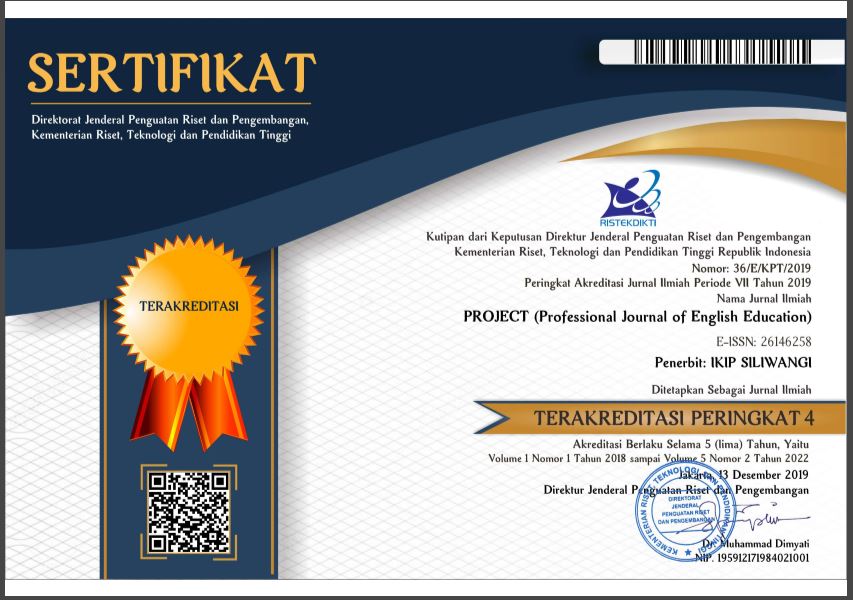DOES STORYTELLING CAPTIVATE STUDENTS IN ICE-BREAKING SESSIONS?: ENGLISH FOR SPECIFIC PURPOSES STUDENTS’ PERCEPTION
Abstract
An attractive yet meaningful activity needs to be conducted as an ice-breaking activity in an ESP class to build a conducive learning environment that relaxes the students. This study aimed to figure out whether storytelling can engage vocational students in tertiary education in an ice-breaking session and the perception of the students. This study employed A qualitative research design involving 51 purposively chosen participants from the English for Specific Purposes class. Observation was carried out and followed by a Focus Group Discussion. The study revealed that the students were entertained by listening to fascinating and unusual stories from the storytellers because the students could capture positive enlightenment in their minds. The students became impatient to attend the ice-breaking session since, after the storytelling, their confidence in speaking was realized to be improved. Although storytelling could captivate the students' attention, lack of vocabulary range, audience engagement, and anxiety were unveiled as obstacles. The topic of destination visits, memorable experiences, and personal growth are the students' favorite. In the future, the students might have both free topics or specific topics regarded to the lesson for storytelling as the ice-breaking to keep the students entertained yet learn something advantageous.
References
Artati, N. L. R. (2021). Effect of Kahoot As an Ice Breaker on EFL Students’ Motivation. The Art of Teaching English as a Foreign Language, 2(2), 89–97. https://doi.org/10.36663/tatefl.v2i2.121
Astuti, A. R., Solihat, A., & Satriani, I. (2020). The Influence of Ice Breaker to Students’ Motivation in Teaching English. PROJECT: Professional Journal of English Education, 3(2), 210–216. https://doi.org/https://doi.org/10.22460/project.v3i2.p210-216
Balula, A., & Vasconcelos, S. (2020). Personal Branding and Storytelling: Tales from the Tourism ESP Classroom. Journal of Tourism & Development, 32, 129–138. https://proa.ua.pt/index.php/rtd/article/view/22423/16282
Chlup, D. T., & Collins, T. E. (2016). Breaking the Ice: Using Ice-breakers and Re-energizers with Adult Learners. 21(3–4), 34–39. https://doi.org/https://doi.org/10.1177/104515951002100305
Chowdhury, S. (2022). Teachers’ Perceptions Towards the Role of Ice-Breaking Activities in Teaching English at the University Level. Journal of ELT and Education, 5(1), 6–11. https://www.researchgate.net/publication/360791049
Creswell, J. W. (2003). Research Design: Qualitative, Quantitative, and Mixed Methods Approaches (Second). Sage Publication, Inc.
Farwati, D. Z., Rahmah, M., & Sutisna, E. (2019). The Application of Ice Breaking Activities in Teaching English to Junior High School Students. Journal of English Teaching and Linguistics Studies (JET Li), 1(1), 16–26. https://doi.org/https://doi.org/10.55215/jetli.v1i1.1489
Heluri, O., Putri, Y., Perdhani, W. C., & Isnaini, M. H. (2021). The Effect of Life-Story-Retelling Technique on Students’ Speaking Fluency. The Journal of English Literacy Education, 8(2), 113–124. http://dx.doi.org/10.36706/jele.v8i2.15260
Huang, X., & Hu, X. (2015). Teachers’ and Students’ Perceptions of Classroom Activities Commonly Used in English Speaking Classes. Higher Education Studies, 6(1), 87. https://doi.org/10.5539/hes.v6n1p87
Kavanagh, M., Clark-Murphy, M., & Wood, L. (2011). The first class: Using icebreakers to facilitate transition in a tertiary environment. Asian Social Science, 7(4), 84–92. https://doi.org/10.5539/ass.v7n4p84
Lee, K. H., Bae, C. W., & Park, J. K. (2022). The Effect of Storytelling and Peer Coaching Classes on Future Creativity Confluence and Creativity of University Students. International Journal of Instruction, 15(3), 611–634. https://doi.org/10.29333/iji.2022.15334a
Miles, M. B., Huberman, A. M., & Saldaña, J. (2014). Qualitative data analysis : a methods sourcebook (3rd ed.). Sage Publication, Inc. https://ezp.lib.unimelb.edu.au/login?url=https://search.ebscohost.com/login.aspx?direct=true&db=cat00006a&AN=melb.b5411150&site=eds-live&scope=site
Mokhtar, N. H., Halim, M. F. A., & Kamarulzaman, S. Z. S. (2011). The Effectiveness of Storytelling in Enhancing Communicative Skills. Procedia - Social and Behavioral Sciences, 18, 163–169. https://doi.org/10.1016/j.sbspro.2011.05.024
Mudianingrum, R. A., Evenddy, S. S., & Rima, R. (2019). An Analysis of Teachers’ Classroom Management in Teaching English. Journal of English Education Studies, 2(1), 1-11.
Nguyen, L. T., & Nguyen, H. B. (2018). The Impact of Storytelling on High School Students’ Oral Performance. European Journal of English Language Teaching, 3(4), 68–83. https://doi.org/10.5281/zenodo.1296378
Nicholas, B. J., Rossiter, M. J., & Abbott, M. L. (2011). The power of story in the ESL classroom. Canadian Modern Language Review, 67(2), 247–268. https://doi.org/10.3138/cmlr.67.2.247
Pranata, M. S. A., Susanti, R. A., & Jannah, Q. (2021). The Effectiveness of Ice Breaking to Increase Students’ Motivation Iin Learning English. International Journal of English Education and Linguistics, 3(1), 31–38. https://doi.org/http://doi.org/10.33650/ijoeel.v3i1.2256
Rokhmawan, T., Daryono, Fuat, Sayer, I. M., Konstantinopoulou, X., Mas’udah, N., & Nafisah, D. (2022). Teachers and Students Benefits Bringing Oral Storytelling in Front of the Classroom. Bulletin of Community Engagement, 2(2), 70–88. https://doi.org/http://dx.doi.org/10.51278/bce.v2i2.426
Satriani, I. (2019). Storytelling in Teaching Literacy: Benefits and Challenges. English Review: Journal of English Education, 8(1), 113–120. https://doi.org/10.25134/erjee.v8i1.1924
Sim, J.-Y., & Kim, E.-H. (2013). A Case Study of a Storytelling Workshop: The Impact on Teachers’ Classroom Practice and Perception Change. English Language & Literature Teaching, 19(3), 271–293.
Downloads
Published
Issue
Section
License

This work is licensed under a Creative Commons Attribution-ShareAlike 4.0 International License.




